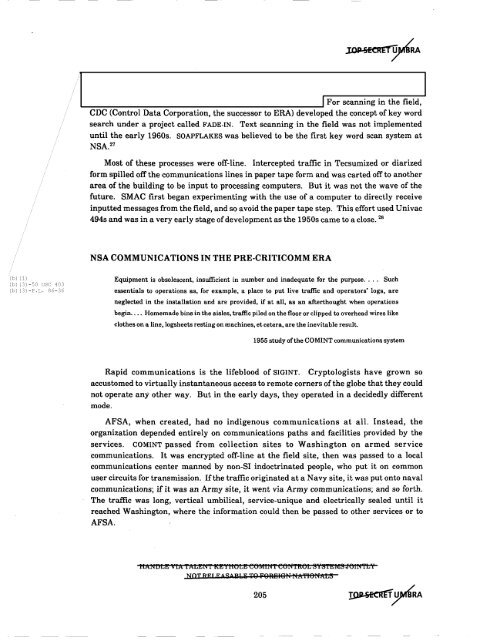American Cryptology during the Cold War - The Black Vault
American Cryptology during the Cold War - The Black Vault
American Cryptology during the Cold War - The Black Vault
You also want an ePaper? Increase the reach of your titles
YUMPU automatically turns print PDFs into web optimized ePapers that Google loves.
---,I For scanning in <strong>the</strong> field,<br />
CDC (Control Data Corporation, <strong>the</strong> successor to ERA) developed <strong>the</strong> concept of key word<br />
search under a project called FADE-IN. Text scanning in <strong>the</strong> field was not implemented<br />
until <strong>the</strong> early 1960s. SOAPFLAKES was believed to be <strong>the</strong> first key word scan system at<br />
NSA. 27<br />
·1 I<br />
__~<br />
Most of <strong>the</strong>se processes were off-line. Intercepted traffic in Tecsumized or diarized<br />
form spilled off <strong>the</strong> communications lines in paper tape form and was carted off to ano<strong>the</strong>r<br />
area of <strong>the</strong> building to be input to processing computers. But it was not <strong>the</strong> wave of <strong>the</strong><br />
future. SMAC first began experimenting with <strong>the</strong> use of a computer to directly receive<br />
inputted messages from <strong>the</strong> field, and so avoid <strong>the</strong> paper tape step. This effort used Univac<br />
494s and was in a very early stage ofdevelopment as <strong>the</strong> 1950s came to a close. 28<br />
NSA COMMUNICATIONS IN THE PRE·CRITICOMM ERA<br />
Ib) (1)<br />
Ib) (3) -50 USC 403<br />
Ib) (3) -P.L. 86-36<br />
Equipment is obsolescent, insufficient in number and inadequate for <strong>the</strong> purpose. . .. Such<br />
essentials to operations as, for example, a place to put live traffic and operators' logs, are<br />
neglected in <strong>the</strong> installation and are provided, if at all, as an afterthought when operations<br />
begin.... Homemade bins in <strong>the</strong> aisles, traffic piled on <strong>the</strong> floor or clipped to overhead wires like<br />
clo<strong>the</strong>s on a line, logsheets resting on machines, etcetera, are <strong>the</strong> inevitable result.<br />
1955 study of<strong>the</strong> COMINT communications system<br />
Rapid communications is <strong>the</strong> lifeblood of SIGINT. Cryptologists have grown so<br />
accustomed to virtually instantaneous access to remote corners of<strong>the</strong> globe that <strong>the</strong>y could<br />
not operate any o<strong>the</strong>r way. But in <strong>the</strong> early days, <strong>the</strong>y operated in a decidedly different<br />
mode.<br />
AFSA, when created, had no indigenous communications at all. Instead, <strong>the</strong><br />
organization depended entirely on communications paths and facilities provided by <strong>the</strong><br />
services. COMINT passed from collection sites to Washington on armed service<br />
communications. It was encrypted off-line at <strong>the</strong> field site, <strong>the</strong>n was passed to a local<br />
communications center manned by non-SI indoctrinated people, who put it on common<br />
user circuits for transmission. If<strong>the</strong> traffic originated at a Navy site, it was put onto naval<br />
communications; ifit was an Army site, it went via Army communications; and so forth.<br />
<strong>The</strong> traffic was long, vertical umbilical, service-unique and electrically sealed until it<br />
reached Washington, where <strong>the</strong> information could <strong>the</strong>n be passed to o<strong>the</strong>r services or to<br />
AFSA.<br />
II*N5LI!: .1* T*LI!:H'T KI!: i II~LI!: e~MI!.T e~HTIt~L SY8TI!:MS J~IHTLY<br />
NOT REI E AS A In.,). '];'Q FQREI8Pf N'k'fIfm1\LS<br />
205
















